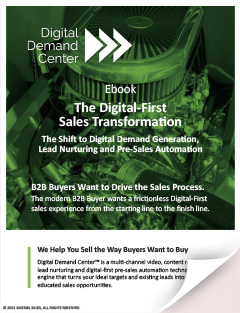 B2B marketing is changing dramatically and it’s going to take an even greater commitment by marketers to embrace and execute effective B2B marketing. Here are the top ten things I believe you need to commit to in 2013 to be part of the transformation B2B marketing is going through.
B2B marketing is changing dramatically and it’s going to take an even greater commitment by marketers to embrace and execute effective B2B marketing. Here are the top ten things I believe you need to commit to in 2013 to be part of the transformation B2B marketing is going through.
1) Commit to multimedia content marketing that truly educates your potential buyers. You want the content to be so strong that your prospects have full-heartedly believe that they are more intelligent around the topics presented in your content than they were before they consumed it. You want it to be diverse in type (video, eBooks, blog posts, webinars, etc.) because people learn differently (and search engines will reward you for the diversified content types).
2) Develop and adhere to a content publishing schedule. This is important for a few key reasons: 1) keeping all responsible parties on track regarding the content creation and publishing cycle 2) establishing a pattern with your audience so they confidently expect new education on a regular basis 3) the ability to batch produce, plan ahead and pre-schedule posting so that when the inevitable interruption deters you, you have a backup plan to get the content out on time anyway.
3) A greater commitment to search engine optimization. The foundations of SEO are in flux with the current state and changes in social media, content marketing, vertical search, continuous search algorithm changes, and more. We believe a full-time commitment to SEO is necessary for all B2B marketing campaign portfolios. It often produces the strongest leads and, when done correctly, has longer lasting passive lead generation benefits that other B2B marketing campaigns.
4) Develop a social media marketing plan. B2B Marketers need to develop and execute an actual social media plan with functions in place to measure the social media ROI. This plan should at least include the use of Facebook, Twitter, Google+, LinkedIn and other social forums that have an industry-related focus.
5) Dig deeper into your web/data analytics goldmine. First, make sure your analytics data is well organized in some type of central reporting area/dashboard. Secondly, establish regular review periods to assess current performance across your KPIs against historical benchmarks. Third, set up instant alerts that notify you of key opportunities or concerns.
6) Implement marketing automation software. 2012 was my maiden voyage into the world of b2b marketing automation software. On the consumer marketing side, I’ve used some tools that do some components of marketing automation, but nothing like what I’ve seen done in the past 6 months. Tools like Pardot, Marketo, Eloqua and a few others are changing the B2B marketing game big time, yet the adoption rate is is still low enough to where you can gain some true competitive advantages if you implement in a timely manner. There are more than a dozen recommended marketing automation strategies that I can think of. Look for an additional blog post on this, but in the mean time read this blog post on how marketing automation helps sales teams.
7) Optimize your landing pages. You are likely sending people to various landing pages through your different marketing channels. Additionally, there are organic landing pages that reveal themselves over time (using Google Analytics data). This is often your best chance to get someone engaged with your company – make it count. There are countless resources for “landing page optimization” some with opposing views, so my number one tip for landing page optimization is make sure you split test.
8) Improve your website’s user experience. Some examples of ways to do this include: 1) Improve your page load time. Page load time is a positive or negative user experience. A fast load time gets potential prospects to your content/message faster. Slow load time keeps your prospects waiting or worse, going elsewhere. People doing research want information fast. If your site doesn’t load swiftly, you are likely losing leads. 2) Consistent and easy to use navigation. You want users to be regular visitors to your site (either for purchases or continued trust building with your site as an authoritative hub). Good navigation helps your users get to where they need to go with ease. This also includes a good internal search engine. 3) Make it easy for them to take the most desired action on each respective page they are visiting, e.g. when offering a free whitepaper, make it abundantly clear what they need to provide and how exactly the whitepaper will be delivered.
9) Create a greater mobile experience for your websites. Whether its a responsive website re-design or delivering a mobile-based theme through device detection, more and more people are using mobile devices to consume content. Personally, I keep my laptop put away late at night and use my mobile devices to do research, solve business problems and to keep communication flowing (e.g. late night email, instant messaging, texting).
10) Get more involved in the lead nurturing and sales education process. Other experts I know in this space are predicting a much greater role to be played by marketers in strengthening demand generation, lead nurturing, and using targeted content marketing for sales education (moving away from just focusing on top funnel lead generation volume). B2B marketers should expect to be more deeply involved in the prospect buying cycle. This will require a more active participation with the sales team, product experts, and, most importantly, prospects themselves.
B2B marketing requires a new breed of marketers – people who are: knowledgeable/experienced in B2B selling, technically skilled, analytical, organized, productive, and business-savvy individuals who work well across teams to champion the creation of high performing, measurable, and predictable lead/demand generation and sales conversion systems.
Now, imagine the workload and personnel commitment required to make all that happen within a single company. First, you need at least one person to get up to speed on the changing tools, technologies, language and strategies required for the new rules of B2B marketing. Then, not only do you need that individual or team to learn all of this, you need them to be able to articulate it clearly across teams so that everyone understands and is on board with the changing rules and processes. Next, you need a diehard commitment to actually managing, implementing and optimizing all the different projects that come about by committing to the 10 issues above. Projects like website redesign, new software implementation, consistent content production, streamlining reporting/analysis, and more are huge undertakings.
At Gabriel Sales, we have:
- gone through the learning curves
- championed the transformation into various companies
- stayed abreast of B2B marketing best practices
- deployed the projects required to meet our B2B marketing recommendations
- continued to hone and optimize our own strategies as well as our clients
Working with an outsourced B2b marketing firm like Gabriel Sales will help you deploy these recommendations more quickly and cost-effectively compared to doing all of the work in-house. If you’d like to learn more about how we would help you, please request a complimentary review here.




